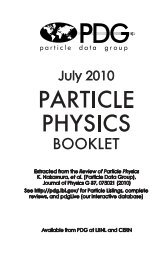30. Passage of particles through matter 1 - Particle Data Group
30. Passage of particles through matter 1 - Particle Data Group
30. Passage of particles through matter 1 - Particle Data Group
Create successful ePaper yourself
Turn your PDF publications into a flip-book with our unique Google optimized e-Paper software.
22 <strong>30.</strong> <strong>Passage</strong> <strong>of</strong> <strong>particles</strong> <strong>through</strong> <strong>matter</strong><br />
<strong>30.</strong>4.3. Critical energy : An electron loses energy by bremsstrahlung at a<br />
rate nearly proportional to its energy, while the ionization loss rate varies only<br />
logarithmically with the electron energy. The critical energy Ec is sometimes<br />
defined as the energy at which the two loss rates are equal [47]. Among<br />
alternate definitions is that <strong>of</strong> Rossi [2], who defines the critical energy as<br />
the energy at which the ionization loss per radiation length is equal to the<br />
electron energy. Equivalently, it is the same as the first definition with the<br />
approximation |dE/dx|brems ≈ E/X0. This form has been found to describe<br />
transverse electromagnetic shower development more accurately (see below).<br />
These definitions are illustrated in the case <strong>of</strong> copper in Fig. <strong>30.</strong>13.<br />
The accuracy <strong>of</strong> approximate forms for Ec has been limited by the failure<br />
to distinguish between gases and solid or liquids, where there is a substantial<br />
difference in ionization at the relevant energy because <strong>of</strong> the density effect. We<br />
distinguish these two cases in Fig. <strong>30.</strong>14. Fits were also made with functions <strong>of</strong> the<br />
form a/(Z + b) α , but α was found to be essentially unity. Since Ec also depends<br />
on A, I, and other factors, such forms are at best approximate.<br />
Values <strong>of</strong> Ec for both electrons and positrons in more than 300 materials can be<br />
found at pdg.lbl.gov/AtomicNuclearProperties.<br />
<strong>30.</strong>4.4. Energy loss by photons : Contributions to the photon cross section in a<br />
light element (carbon) and a heavy element (lead) are shown in Fig. <strong>30.</strong>15. At<br />
low energies it is seen that the photoelectric effect dominates, although Compton<br />
scattering, Rayleigh scattering, and photonuclear absorption also contribute. The<br />
photoelectric cross section is characterized by discontinuities (absorption edges)<br />
as thresholds for photoionization <strong>of</strong> various atomic levels are reached. Photon<br />
attenuation lengths for a variety <strong>of</strong> elements are shown in Fig. <strong>30.</strong>16, and data for<br />
30 eV< k







